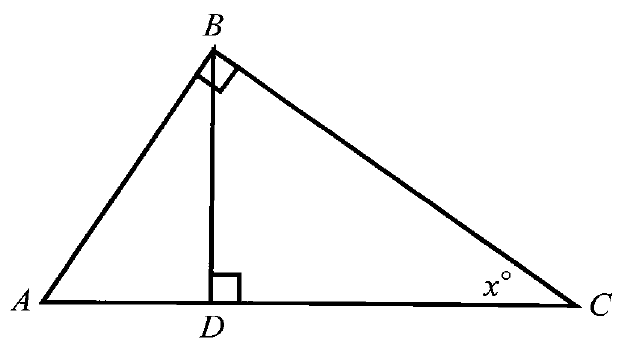HOW TO FIND LCM OF TWO NUMBERS IN DECIMAL
The smallest among the common multiples of two or more numbers is called their least common multiple ( LCM)
In this section, we will learn, how to find least common multiple of two or more numbers in decimal.
Step 1 :
Convert all the given decimal numbers into integers using multiplication of 10 or 100 or 1000.......
For example, if you want to find lcm of 0.2 and 0.35, find the number in which you have more number of digits after the decimal. In 0.35, you have more number of digits after the decimal point. That is, two digits.
So, multiply both the numbers 0.2 and 0.35 by 100 to get rid of the decimal point and make them to be integers.
Step 2 :
After multiplication of 10 or 100 or 1000......, find the lcm of the integers you get in step 1.
Step 3 :
Divide the lcm you get in step 2 by 10 or 100 or 1000.....by which you multiplied the given decimal numbers in step 1.
Example 1 :
Find the least common multiple of 0.90 and 0.30
Solution :
In the given two numbers 0.90 and 0.30, we find equal number of digits after the decimal point in both the numbers. That is, two digits.
To get rid of the decimal point, we have to multiply each number by 100.
0.90 ⋅ 100 = 90
0.30 ⋅ 100 = 30
Find the lcm of 90 and 30.
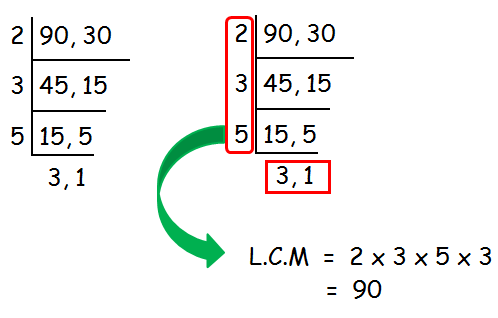
LCM of 90 and 30 is 90.
Divide the lcm (90) by 100.
90 / 100 = 0.9
So, the least common multiple of 0.90 and 0.30 is
0.9
Example 2 :
Find the least common multiple of 0.36 and 0.27.
Solution :
In the given two numbers 0.36 and 0.27, we find equal number of digits after the decimal point in both the numbers. That is, two digits.
To get rid of the decimal point, we have to multiply each number by 100.
0.36 ⋅ 100 = 36
0.27 ⋅ 100 = 27
Find the least common multiple of 36 and 27.
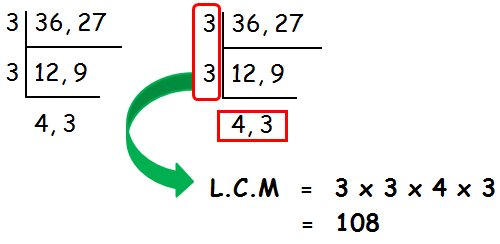
Least common multiple of 36 and 27 is 108.
Divide the least common multiple (108) by 100.
108 / 100 = 1.08
So, the least common multiple of 0.36 and 0.27 is
1.08
Example 3 :
Find the least common multiple of 0.75 and 0.45.
Solution :
In the given two numbers 0.75 and 0.45, we find equal number of digits after the decimal point in both the numbers. That is, two digits.
To get rid of the decimal point, we have to multiply each number by 100.
0.75 ⋅ 100 = 75
0.45 ⋅ 100 = 45
Find the least common multiple of 75 and 45.
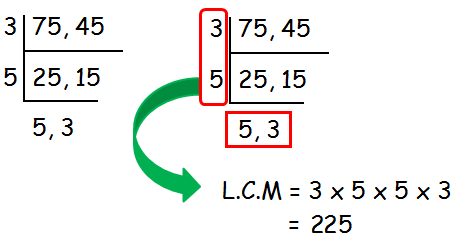
Least common multiple of 75 and 45 is 225.
Divide the lcm (225) by 100.
225 / 100 = 2.25
So, the least common multiple of 0.75 and 0.45 is
2.25
Example 4 :
Find the least common multiple of 0.36 and 0.72.
Solution :
In the given two numbers 0.36 and 0.72, we find equal number of digits after the decimal point in both the numbers. That is, two digits.
To get rid of the decimal point, we have to multiply each number by 100.
0.36 ⋅ 100 = 36
0.72 ⋅ 100 = 72
Find the least common multiple of 36 and 72.
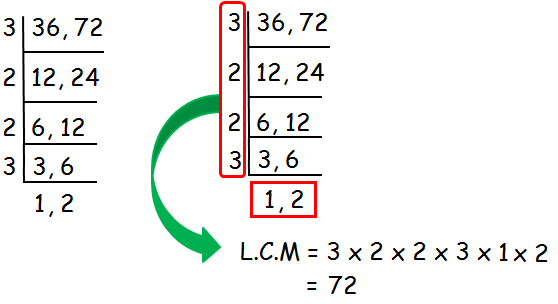
Least common multiple of 36 and 72 is 72.
Divide the lcm (72) by 100.
72 / 100 = 0.72
So, the least common multiple of 0.36 and 0.72 is
0.72
Example 5 :
Find the least common multiple of 0.72 and 0.63.
Solution :
In the given two numbers 0.72 and 0.63, we find equal number of digits after the decimal point in both the numbers. That is, two digits.
To get rid of the decimal point, we have to multiply each number by 100.
0.72 ⋅ 100 = 72
0.63 ⋅ 100 = 63
Find the least common multiple of 72 and 63.
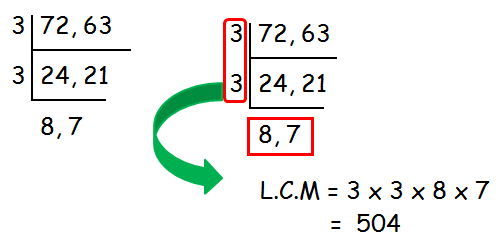
Least common multiple of 72 and 63 is 504.
Divide the lcm (504) by 100.
504 / 100 = 5.04
So, the least common multiple of 0.72 and 0.63 is
5.04
Kindly mail your feedback to v4formath@gmail.com
We always appreciate your feedback.
©All rights reserved. onlinemath4all.com
Recent Articles
-
Digital SAT Math Problems and Solutions (Part - 144)
Apr 14, 25 07:27 PM
Digital SAT Math Problems and Solutions (Part - 144) -
Quadratic Equation Problems with Solutions (Part - 1)
Apr 14, 25 11:33 AM
Quadratic Equation Problems with Solutions (Part - 1) -
Quadratic Equation Problems with Solutions (Part - 2)
Apr 14, 25 11:22 AM
Quadratic Equation Problems with Solutions (Part - 2)
